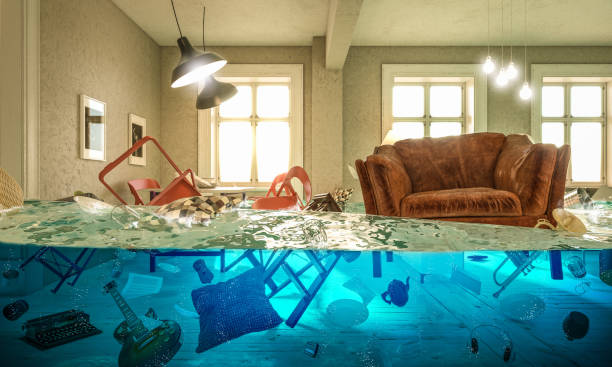Water’s dual nature makes it both a tremendous life-giver and a devastating force when it floods or evaporates.
Numerous events can lead to water damage in your house, including pipe bursts, floods, appliance leaks, and sewage backups. It’s for this reason that you must immediately initiate the cleanup.
Common reasons for water damage
Here are some reasons that may cause water damage to your home or properties.
Natural disaster
Hurricanes, tornadoes, and extreme rainfall are all natural disasters that might cause damage to your house or even other properties.
Man-made reasons
Several things can cause water damage, but one of the most prevalent is a burst pipe, which can lead to anything from a minor leak to substantial damage, and is typically a big problem when the weather becomes cold.
Other issues usually stem from subpar plumbing installation, such as shoddy waterproofing or ill-fitting supply lines. When a toilet overflows, it’s usually because of the user’s carelessness, but it could also be a sign of more serious plumbing issues.
Also, remember that it can come from home appliances, such as washing machines and dishwashers. When these appliances leak, not only do they cause damage to the appliance itself and generate widespread wetness throughout your home’s walls, floors, attics, and even ceilings, which can lead to mold infestation throughout the entire house.
What to do after a residential home damage
Sneezing, a runny nose, red eyes, and rashes are all indicators of a fever that can be brought on by mold and poor indoor air quality brought on by water damage. If you don’t take the time to clean up after a flood thoroughly, you risk endangering your family’s health and ruining your home’s structure from microbial growth and other contaminants.
Taking immediate action will reduce the likelihood of additional water damage, mold growth, and other negative consequences.
Contact your insurance agency
Insurance companies should be your first port of call. You must be aware of your level of protection. Make sure to contact them as soon as you can.
Call a professional company for cleaning
You’ll certainly need the help of a professional water dryout or cleanup company. They will help you remove or drain any remaining water in your house.
Hire a reliable contractor and get the services of a qualified electrician
A specialist in repairing water damage to buildings is a must. You must do the standard checks of the company’s history and reputation. Make sure you use the services of a reliable contractor.
In addition, to ensure everyone’s safety, have an electrician inspect your wiring before turning the electricity back on. This is especially true if the water gets into your electrical panel, plugs, and switches or goes into your fixtures and appliances.
Change your flooring
Those sections of flooring that are damaged must be removed. Even the subfloor of a laminate or hardwood floor may swell and deform if it becomes soaked. All soaked carpets need to be thrown out.
Allow the walls to dry up by removing drywall
Mold can form on anyone if the conditions are right. Drywall is typically installed over wooden studs. For the studs to dry out, your contractor will have to cut into the walls. Your contractor should cut away at least 1 foot of drywall from the ceiling above the water line and down to the floor; however, the further down the drywall is taken, the better.
Strip away wall insulation
Your walls will always be damp since the insulation can never dry out. That can cause air quality issues, the growth of mold and mildew, and structural damage to your property. The center of a wood stud can be moist even though the surface is dry.
When the contractor removes the drywall and insulation, you should leave the wall cavity open, so any moisture can evaporate. This may take a few weeks. Hence, allow moisture evaporation by leaving the wall cavity open.
Reconstruct the basement
Your best option is to completely tear the basement down to the foundation walls and start again. In this manner, it can be properly reconstructed utilizing mold-resistant drywall. However, this may depend on the extent of the damage.
FAQs
How much time do I need to repair a water-damaged home?
How long it will take to fix something depends on the problem’s specifics, but you can use several ballpark figures. Drying out a larger water-damaged space takes more time. No matter how extensive the damage is, a set procedure must be followed to restore the quality of the indoor environment fully.
After 72 hours, water-damaged surfaces should be dry again. However, even if the water is fully gone within 72 hours, the damage may not be completely repaired for several weeks.
Hence, the time and effort required to restore a home after water damage might vary widely. The time it takes to restore your property depends on several variables, like its size, the type of flooring it has, the number of affected places, and so on.
How much should I spend on average to restore a water-damaged home?
The considerable rebuilding and repairing that may be necessary once the problem has been fixed and the house has dried out contributes significantly to the high price tag of water damage restoration.
Breaking pipes, leaking roofs, defective appliances, basement backups, and other water sources can lead to costly repairs. When water damage occurs, no matter the source of the leak, all affected surfaces must be thoroughly dried.
The price tag for fixing water damage could rise to $4000–$8000 or more if a lot of standing water needed to be drained before repairs could be made.
If only one room was flooded, for instance, the cost of fixing the damage might be limited to replacing the affected flooring and baseboards. The price tag to fix the water damage in your property could range from $2000 to $4000, depending on the building materials used.






